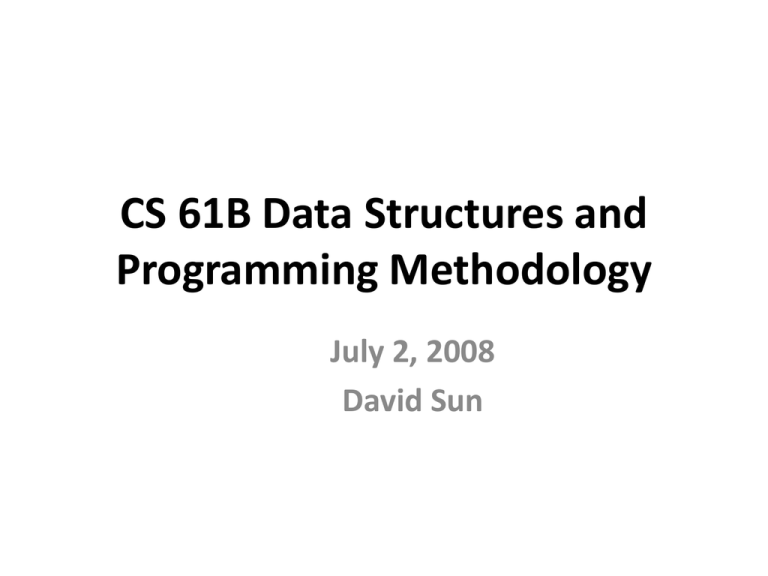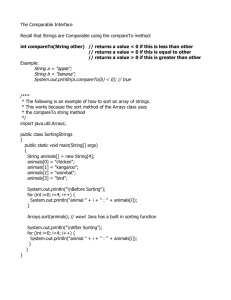Interfaces and Abstract classes
advertisement

CS 61B Data Structures and
Programming Methodology
July 2, 2008
David Sun
Announcements
• Project 1 spec and code is available on the
course website. Due July 15th. Start early!
• Midterm I is next Wed in class from 11:00 –
1:00p.m. Open book: lecture notes, lab
notes, but no laptop!
Today
•
•
•
•
Constants
Preventing Inheritance
Abstract Classes
Interfaces
Static Fields and Methods
class Parent {
class Child extends Parent {
String x = "no";
int x = 0;
static String y = "way";
static int y = 1;
static void f() {
static void f() {
System.out.printf ("I wanna!%n");
System.out.printf "Ahem!%n"); }
}
}
static int f(int x) {
return x+1;
}
}
Child dave = new Child(); dave.x => no
Parent pDave = dave;
dave.y => way
dave.f() => ?
dave.f(1) => ?
pDave.x => 0
pDave.y => 1
pDave.f() = ?
pDave.f(1) => 2
Fields hide inherited fields of same name; static methods hide
methods of the same signature.
Constants
• Adding final in front of a variable means that the
value of the variable can never be changed.
– You must initialize the value of the final variable when it
is declared.
– Use final variables to create constants.
class Math {
public static final double PI = 3.141592653…;
}
public class System {
public static final PrintStream out = … ;
}
Constants (cont.)
• Numerical values that are used repeatedly should
be turned into a final constant.
if (month == 3) { . . .} //BAD
public static final int MARCH = 3;
if (month == MARCH) { . . . }
• Not all constants need to be static.
– For an array x, x.length is a final field.
Preventing Inheritance
• A class declared to be final cannot be extended by others
final class Executive extends Manager{
}
• A method declared final cannot be overriden by
subclasses
– All methods in a final class are automatically final
class Employee
{
…
public final String getName()
{
return name;
}
…
}
Abstract Classes
• As we move up the inheritance hierarchy,
classes become more general or more
abstract.
• At the some point, the ancestor class becomes
so general that it becomes a basis for other
classes rather than a class with specific
instances that you want to create.
• Such ancestor classes are declared to be
abstract. Their sole purpose is to be extended.
Example
Human
Employee
Student
• Some attributes and methods make sense for every human,
and these can be factored out into the Human class.
public class Human {
. . .
private int age;
private String name;
public int getAge() { return age};
public String getName() { return name};
. . .
}
Example (cont.)
public class Human {
. . .
public String introduce() { . . .}
}
//how should we code this?
Student david = new Student( . . . );
david.introduce(); //”I’m David and I major in Computer Science”
Employee wendy = new Employee( . . . );
wendy.introduce(); //”I’m Wendy I work for Google”
• The Human class knows nothing about the person except the
name and age.
• We can try:
public String introduce() {
return “”;
}
• A better way:
public abstract String introduce(); //no implementation required
Abstract Class
public abstract class Human {
private String name;
public Human(String n);
public String getName() { return name; }
public abstract String introduce();
}
• Any class with one or more abstract methods must
be declared as abstract.
• abstract classes can have concrete data and
methods.
• abstract methods act as placeholders for methods
that are implemented in subclasses.
public abstract class Human {
private String name;
. . .
public abstract String introduce();
}
public class Student extends Human{
private String major;
public student(String name, String major) {. . .}
public String introduce() {
return “I’m “ + name + “and I major in” + major;
}
}
public class Employee extends Human{
private String company;
public student(String name, String company) {. . .}
public String introduce() {
return “I’m “ + name + “and I work for ” + company;
}
}
Rules for abstract Classes
• The concrete classes Student and Employee must
implement the abstract method introduce().
– The compiler will generate an error if you don’t.
• If you extend an abstract class without implementing an
abstract method, the subclass must be declared as
abstract.
• You can create a variable of an abstract class:
Human student; //OK
• You cannot create an object of an abstract class:
//Compile time ERROR!
Human student = new Human(“David”);
//OK!
Human student = new Student(“David”);
student.introduce();
Example
Human[] human = new Human[2];
human[0] = new Employee( ... );
human[1] = new Student( ... );
for (int i = 0; i < human.length; i++) {
human[i].introduce();
}
• The call human[i].introduce(); is well defined
because human[i] never refers to an object of the
abstract human class, it must refer to a concrete subclass.
What are Interfaces?
• Describing what classes should do, without
specifying how they would do it.
• Think of it as a contract for a set of classes.
“If your class conforms to the requirements set in
this contract (or this interface), then I’ll perform
these services for the objects of your class”
Example
• The sort method of the Array class
promises to sort an array of objects, but
under one condition: the objects in the array
must implement the Comparable interface:
public interface Comparable {
Like an abstract method,
int compareTo(Object other); no implementation is
provided
}
Example
public interface Comparable {
int compareTo(Object other);
}
public class Employee implements Comparable {
public int compareTo(Object other) {
...
The Employee class must
}
implement the compareTo
}
method. i.e., define a
method named compareTo
that takes an Object and
returns an int.
compareTo
• When we call x.compareTo(y), the method returns
an indication whether x or y is larger:
– return a negative number if y is larger
– a positive number if x is larger,
– zero otherwise.
• Suppose we want to sort by salary:
public class Employee implements Comparable {
public int compareTo(Object other) {
Employee otherEmployee = (Employee) other;
if (salary < otherEmployee.salary) return -1;
if (salary > otherEmployee.salary) return 1;
return 0;
}
}
Example
compareTo
• If the objects are not equal, it does not matter
what negative or positive value your return.
• For instance, to sort by employee ID number:
//negative if the first ID is less than the other,
//0 if they are the same;
//some positive value otherwise.
return id – other.id;
• The subtraction trick works only for integers:
salary – other.salary can round to 0 if the salaries
are close enough.
Comparable
• An interface to describe Objects that have a natural
order on them, such as String and Integer.
• Might use in a general-purpose max function:
/** The largest value in array A, or null if
A empty. */
public static Comparable max (Comparable[] A)
{
if (A.length == 0) return null;
Comparable result = A[0];
for (int i = 1; i < A.length; i += 1)
if (result.compareTo(A[i]) < 0) result = A[i];
return result;
}
• Now max(S) will return maximum value in S if S is an
array of Strings, or any other kind of Object that
implements Comparable.
Properties of Interfaces
• Interfaces are not classes, you can’t construct
objects:
x = new Comparable( … ); //ERROR
• You can declare interface variables:
Comparable x; //OK
• An interface variable must reference an
object of a class that implements the
interface.
x = new Employee(…); //OK
Properties of Interfaces
•
All methods in an interface are automatically
public.
–
•
int compareTo(Object other);
was not explicitly declared to be public. The
implementation in Employee class must be
public int compareTo(Object other);
otherwise the compiler will complain.
All fields in are automatically public static
final.
–
Interfaces can contain only constants, never instance
variables.
Extending Interfaces
• You can extend interfaces to go from
greater degree of generality to a greater
degree of specialization.
• Example: Java Collections Framework
public interface Set extends Collection{ . . .}
Interfaces and Abstract Classes
abstract class Comparable {
public abstract int compareTo(Object other);
}
public class Employee extends Comparable {
int compareTo(Object other) {
...
}
}
public class Employee extends Human, Comparable //ERROR
public class Employee extends Human implements
Comparable //OK
• A class can have one and only one superclass.
Implement Multiple Interfaces
interface Readable {
Object get();
}
void copy (Readable r,
{
w.put(r.get());
}
Writeable w)
interface Writeable {
void put (Object x);
}
class Source implements Readable class Sink implements Writeable
{
{
Object get() { . . .}
void put (Object x) { .. . }
}
}
class Variable implements Readable, Writeable {
Object get() { . . .}
Object put() { . . .}
}
Using Interfaces and Abstract Class
• Example
The Java Collections Framework
Next Lecture
• Readings:
– Head First Java, Chapter 7



